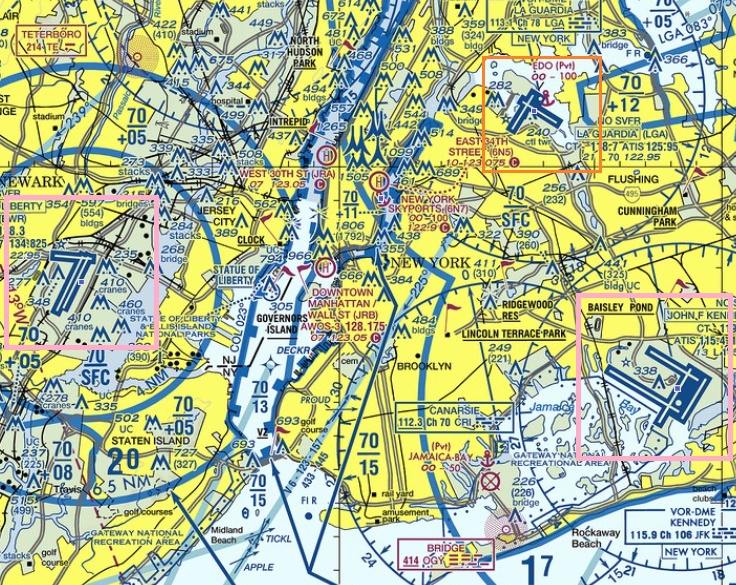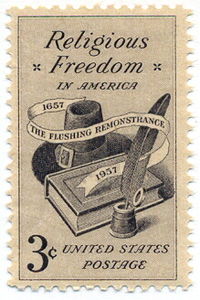Aviation Impact Reform (aiREFORM)
Posted on May 15, 2015
It would be hard to find a community in the entire United States with more history than Flushing, just east of LaGuardia Airport in Queens, NY. It also would be hard to find a community more adversely impacted by FAA’s NextGen implementation.
This Post will look briefly at the impacts, then take a deeper look at the early history of Flushing, which was highly relevant to the American ideal of individual rights and ‘freedom’. Maybe we can find some context that can help reverse FAA’s impactful NextGen failures….
FAA’s NextGen Impacts
LaGuardia Airport [KLGA] opened in 1939, and is one of three major airports serving the New York City area (the others are Newark [KEWR] and Kennedy [KJFK]). The airport was built mostly on fill in the East River. Elevations are so low that passenger gates and runways were flooded by Hurricane Sandy, just before the 2012 election.

LaGuardia (orange square) impacts flows at both Newark (pink square, left side) and JFK (pink square, bottom-right corner).
The location of LaGuardia is highly problematic, as the KLGA flights create conflicts with aircraft flowing into and out of the larger airports at Newark and Kennedy. In fact, the incredibly circuitous arrivals we have all experienced to both airports (especially to KJFK!) are almost entirely due to the airspace conflicts created by the LaGuardia proximity and runway alignments. Simply put, in all but sunny, clear-sky weather conditions, arrivals to LaGuardia nearly always interfere with arrivals to either KEWR or KJFK. As such, the idea of actually shutting down LaGuardia would likely produce huge benefits for both safety and efficiency into and out of the NYC airports.
As a way to manage the airspace conflicts, FAA has for decades imposed limits on the total number of hourly takeoffs and landings (slots) allowed at KLGA. The airlines keep pushing FAA (and Congress) to eliminate these limits, but with no parallel runways at KLGA, the only way to do this is to abandon all noise abatement procedures. Why do the airlines want to conduct more KLGA flights? Because Delta and other airlines use LaGuardia as a mini-hub, which inflates the number of flights. NOT for passengers who want to fly in/out of the congested NYC area, but for thousands of other passengers using KLGA as a ‘passenger sorting facility’, just to pass through and connect from one flight to another. Given the congestion, this hubbing practice at KLGA is absolutely nonsensical. If FAA truly served the entire Public (not just the airlines), they would manage KLGA with guidelines that disallow hubbing, due to the airport’s unique situation.
NextGen’s most notable adverse impact is caused by the TNNIS departure procedure. Once upon a time, FAA would try to minimize noise impact. A very common strategy was to identify corridors that were already noisy (freeways, railroad tracks, industrial areas) and areas with minimal population, then design arrival and departure routes over these areas. For many decades, LaGuardia departures taking off from Runway 13 (toward the southeast) would make a right turn and proceed south a couple miles over Flushing Meadows Park. These departures would then make a left turn and continue climbing northeast-bound, over the Long Island Expressway. This was hugely beneficial as it gave these departing passenger flights an extra couple thousand feet of altitude, greatly reducing the noise impacts in the Flushing neighborhoods. This noise abatement procedure was known as the Whitestone Climb.
With the implementation of NextGen, FAA has simply thrown away their noise abatement procedures. Procedures like the Whitestone Climb that allow airports to coexist with airport neighbors are simply being ignored. Frankly, it appears that FAA made a deal with the devil: they promised the airlines that, if the airlines came on board and promised to not oppose NextGen, FAA would ‘return the favor’ by using NextGen as cover, to justify tighter departure and approach patterns, with turns lower and closer to the runways. This essentially is a workaround to no longer have to comply with the environmental restrictions and planning procedures created in the last five decades.
A 4/30/2015 ‘Queens Chronicle’ article by Laura Shepard (scrollable view below) does a good job discussing the impacts…
“John Bowne built his house in 1661 … LaGuardia Airport opened in 1939 … Now the structure, the oldest house in Queens, vibrates when jets fly overhead and the windows are coated in soot and particulate matter … This was not the case a few years ago.”
Flushing’s Place in Early U.S. History
In the United States, nearly all of us are taught at a very young age about the early history of our nation. We learn not just from our schools, but from our annual holidays. Thanksgiving is one of those holidays. It nurtures a sense of pride, while also presenting our children with values to absorb and role models to follow. We learn that the Pilgrims are an example of an oppressed group who took action to regain their freedom. A group that, in 1620, risked their lives sailing across the Atlantic in the Mayflower, primarily to exercise their religious freedom. That, of course, was just the start of what became centuries of mass migration, to ‘the land of the free and the home of the brave’.

1655: First Slave Auction in Flushing
In 1645, settlers built a new community on the eastern bank of Flushing Creek. The settlers were chartered under the Dutch West India Company, and they named the town after the Dutch city of Vlissingen, which was later anglicized to ‘Flushing’. Slaves were used for labor and, by the mid-1660’s, 20% of residents under the charter were slaves. [for more about the slavery history, see this excellent article by Tony Carnes]
Many English colonists had been drawn to Dutch settlements in North America because the Netherlands was the most religiously tolerant nation in Europe. One of the early colonists was John Bowne. Born in England in 1627, he emigrated to Boston in 1648. By 1656, Bowne had purchased land in Flushing and had started a family with his new wife, a relative of Massachusetts governor John Winthrop. They settled on the land in Flushing and, in 1659, they joined the Quaker faith.

1657: the Flushing Remonstrance
Although the colonists came for religious freedom, it did not take long for religious oppression to reappear. In 1656, the New Amsterdam Director-General, Peter Stuyvesant, had imposed an ordinance formally banning the public practice of all religions except the Dutch Reformed Church. This precipitated the Flushing Remonstrance, in December 1657, when a group of thirty sent a signed petition to Stuyvesant, protesting his discriminatory ordinance. The ordinance had been aimed mostly at Quakers, a very new religion that was being widely persecuted. Impressively, none of those who signed the protest were actual Quakers.
The attitude of authorities was reflected by Stuyvesant’s response: he removed those lower government officials who had signed, and ordered a few imprisonments. And he also proclaimed March 13, 1658 a Day of Prayer for the purpose of repenting from the sin of religious tolerance. That one may need to sink in:
“…Day of Prayer for the purpose of repenting from the sin of religious tolerance….”
What an incredible attitude, being imposed by an unaccountable authority figure. But, Bowne and a few others rejected this attitude. More than 350-years ago, history was made in Flushing, because Bowne and his young family found no religious freedom. Here is what happened, as excerpted from Bowne’s biography, posted by BowneHouse.org:
“John Bowne is best known for his courageous defense of religious freedom. Flushing was then part of the colony of New Netherland, and its town charter, granted by the Dutch West India Company in 1645 guaranteed “liberty of conscience.” When Governor Peter Stuyvesant prohibited the practice of religions other than the Dutch Reformed Church, town leaders delivered the Flushing Remonstrance to Stuyvesant, challenging his edict, which was aimed chiefly at Quakers. In 1662, John Bowne openly defied the ban and allowed Quakers to hold services in his home. Bowne was arrested and imprisoned, and when he refused to pay a fine or plead guilty, Stuyvesant banished him to Holland, where he argued his case successfully before the Dutch West India Company. Stuyvesant was ordered to permit dissenting faiths to worship freely. John Bowne returned home victorious in 1664, and the principle of religious freedom was established in the New York Colony. His actions and those of his fellow residents of Flushing established principles that evolved into the Bill of Rights of the United States Constitution.”
Places Change…
…and we depend on agencies like FAA to properly manage that change. We depend, but if the agency fails, we all suffer.
FAA’s current impact upon the residents of Queens, particularly those in downtown Flushing, is both senseless and insensitive. FAA is abusing their federal authority by misapplying the NextGen technologies we all paid taxes for, to impose new procedures that save airlines a million here and a million there, while literally destroying our residential homes. Even our very oldest historic homes, like the Bowne House.
More than three centuries before FAA was created, and 350 years before FAA got Congress to approve their NextGen ‘Categorical Exclusions (CATEXs)’, John Bowne stood strong against Stuyvesant’s abuse of authority. He was forced to cross the Atlantic to be heard. In the process, he and his Flushing neighbors created the template for what became our Declaration of Independence. And they did so a century before the American Revolution, even before George Washington and Thomas Jefferson had been born.
FAA may destroy John Bowne’s historic home, but by the grace of God, some who care will stand up, to preserve what this nation used to stand for. With a little help from Congress, FAA’s NextGen Noise Impacts can be stopped. With a lot of heart from our best citizens, FAA’s injustices will soon end.
“At LaGuardia, they tried to make it work in the past and there’s just no effort now. How many planes can you squish into this overly congested airspace?”
“The biggest insult of all is the FAA saying nothing has changed. I don’t appreciate the attitude that ‘You’re by the airport, you should expect this noise.’ … It makes me so angry to see this done to this historic, thriving community.”
- comments by Susan Carroll, excerpted from the 4/30/2015 Qchron.com article
Here is a short video with Susan Carroll addressing a community gathering at Cunningham Park, in September 2014: [transcript]


{ 0 comments… add one }